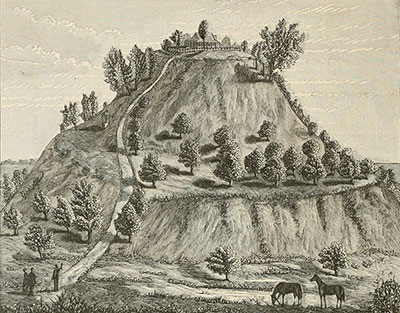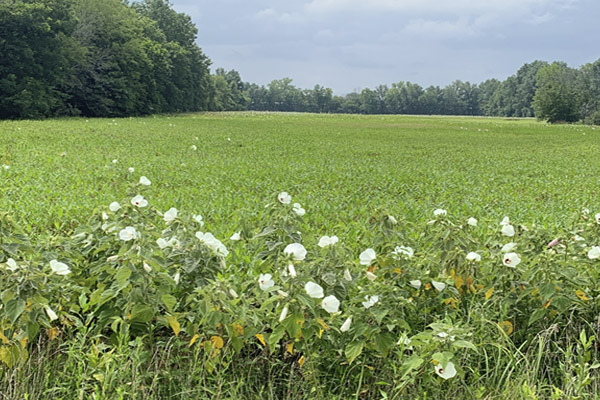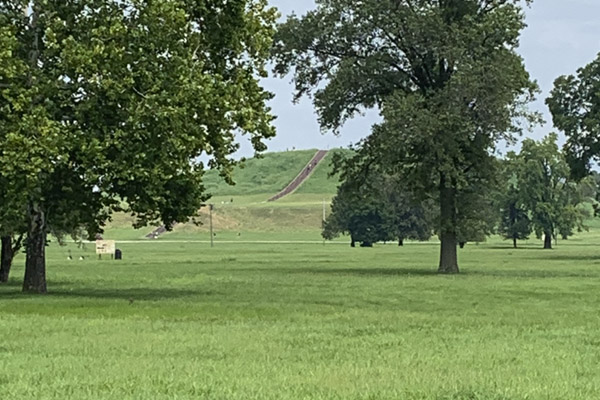Cahokia Mounds State Historic Site, an UNESCO World Heritage Site

Site: Cahokia Mounds State Historic Site
Locations: 30 Ramey St, Collinsville, IL 62234
Google Maps Link
Date of visit: July 2024

Our visit to Cahokia started at the parking lot south of the visitor center. I was attracted to the nearby wetlands, where marsh mallow, Althaea officinalis, was in bloom. This plant is not native, so it would not have been there in the past. We saw a nearby trail and briefly walked to get our bearings. I saw Monk's Mound in the distance across the road and realized we were close to the central plaza. It was a nice summer day, and the plants were lush. This area is called the America Bottom, the Mississippi River flood plain with rich alluvial soil. Next came a small section of the central stockade that had surrounded Cahokia's inner precinct. I saw a deer grazing a short distance away near a stand of trees. Approaching a small mound, I read the marker and was startled to see we were at a place where at least 250 people had been buried, some as a ritual sacrifice.
Mound 72
Mound 72 is a modest size and doesn't stand out. It is a ridgetop mound with a fold along the top and steepled sides. Most of the other mounds at Cahokia have flattened tops. The mound was also set at an angle to align with the summer and winter solstices. The rest of Cahokia is thought to be a planned city using a grid following the cardinal directions: North, South, East, and West. In 1967, Melvin Fowler and his team of archeologists dug into Mound 72 and discovered "the beaded burial." There were two corpses buried, one on top of the other. Some sources say it was two elite men, and I have also seen it referred to as a man and a woman. The top one was buried in a shroud, on a wooden palette, and covered by a beaded cape or garment about six feet in length. It was shaped like a bird with a head, wings, and tail. This was a complex dig, and the number of bodies was a surprise. In pits around the primary burial, they found fifty-three women and other remains. Some may have been willing sacrifices, but others met more brutal deaths.

Monk's Mound
I had seen photos of Monk's Mound, but it was hard to grasp its size until I climbed it myself. It is the largest earthwork north of Mexico and is nine to ten stories tall. The day we were there, it was busy with many visitors, and one man was exercising, running up and down the steps. The second story looked like it could hold a small village. Once on top, I looked to the west and saw St. Louis, once known as the Mound City, with 40 earthworks. We could also look down at the central plaza and to the woodhenge.
Early Explorers
The first recorded mention of Cahokia was in 1813, a letter from Henry M. Brackenridge to Thomas Jefferson. Brackenridge was very insightful, and it took years for historians to catch up to his ideas.
"the valey of the mississippi, there exist the traces of a population far beyond what this extensive and fertile portion of the Continent, is supposed to have possessed: greater perhaps, than could be supported of the present white inhabitants, even with the careful agriculture practised in the most populous parts of Europe."
He mentions fourteen sites, Cahokia being number eleven on the list.
"The great mound of Cohokia, is evidently constructed with as much regularity as any of the Teocalli of new Spain, and was doubtless cased with brick or stone, and crowned with buildings, but of these no traces remain."
I searched to see if Lewis and Clark knew about Cahokia and found a curious Facebook page. Captain Lewis arrived in Cahokia in 1803. At the time, the post office there was the farthest west link to send messages to Washington to make reports. There was no mention of the earthworks.
In 1050 to 1100 CE, Cahokia was a city with 30,000 people, larger than most European cities at the time. It's hard to believe it was lost. I can imagine songs written either to mourn or celebrate its fall like Giuseppe Verdi's Nabucco: "Va Pensiero." Researchers find it useful because they can track the entire urban life-cycle from a small village to the "big bang" and then the decline. Most human settlements are built on top of older versions of themselves, where people live for centuries or millennia.
The research into Cahokia is ongoing. I enjoyed reading Four Lost Cities, A Secret History of the Urban Age by Annalee Newitz. One of the questions researchers ask is why people deserted Cahokia and whether it applies to making our cities future-proof.
Links to more information
- Cahokia Mounds State Historic Site website
- Cahokia mound-72 Cahokia Mounds State Historic Site website
- Henry M. Brackenridge To Thomas Jefferson 25 July 1813 Founders Online
-
Cahokia -
Lewis & Clark Expedition
1803-1806
The Historical Marker Database - Lewis and Clark State Historic Site with Brad Winn, Site Superintendent. Youtube.com
- Cahokia Wind (Grant Maloy Smith and Kevin Lucas) Music Inspired by Cahokia Youtube.com
- A Symphony Cahokia Mounds Inspired Symphony at SLSO Youtube.com
References
- Pauketat, T. R. (2009) Cahokia, Ancient America's Great City on the Mississippi
Viking, The Penquin Library of American Indian History, New York, N.Y. Link to Illinois Experts. - Newitz, A. (2021) Four Lost Cities: A Secret History of the Urban Age
W. W. Norton & Company; First Edition (February 2, 2021), New York, N.Y. Link to wwnorton.com